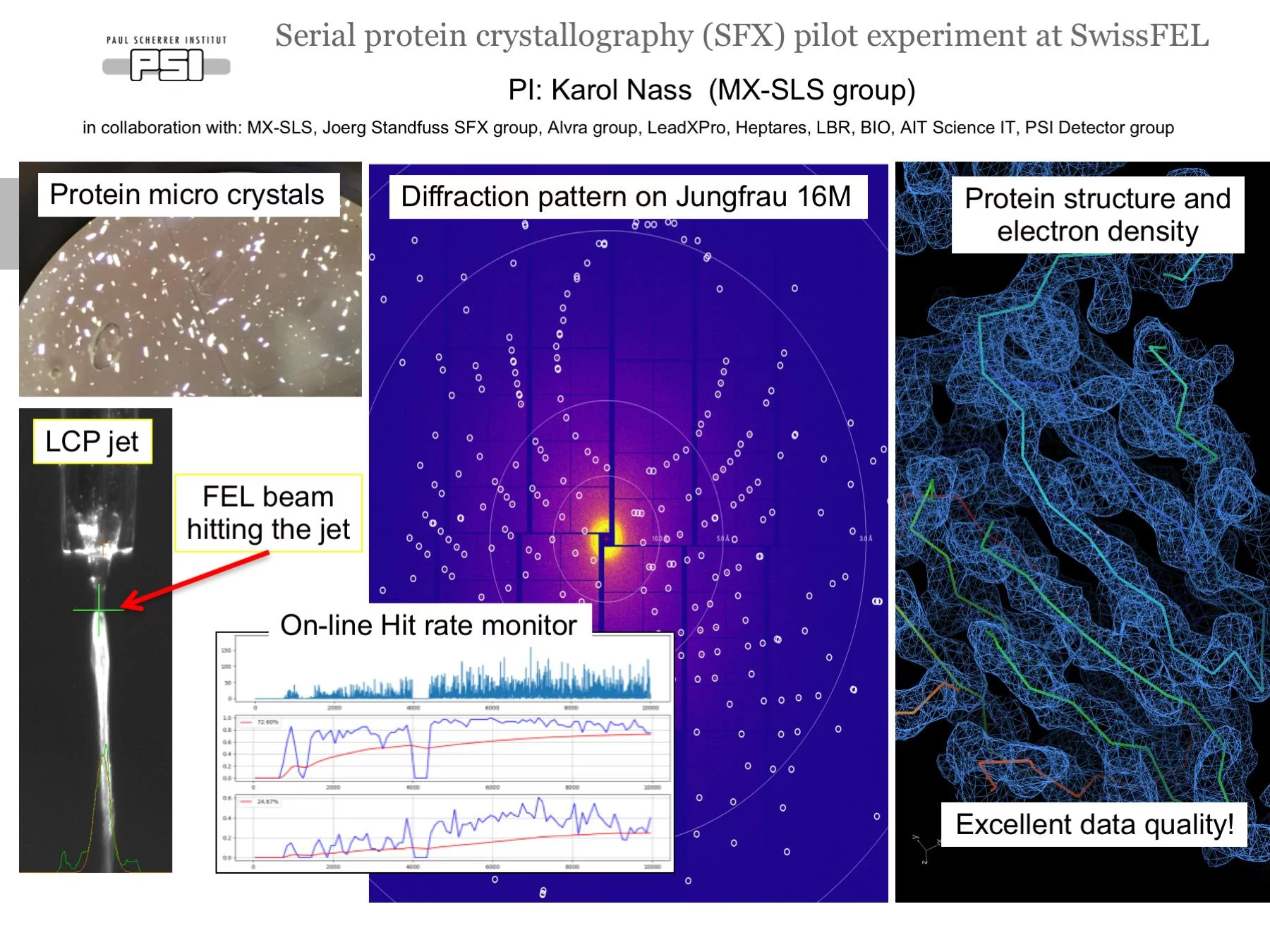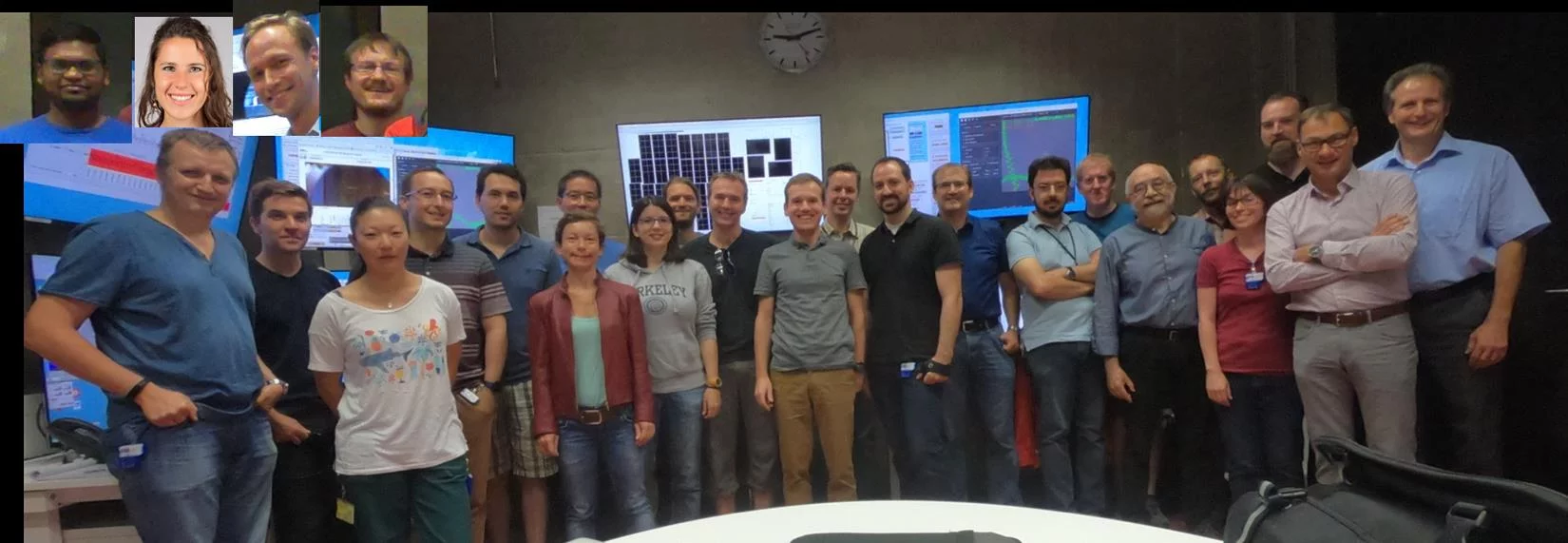On the 7th to 12th of August 2018, a collaborative group of scientists from the Paul Scherrer Institute and members of the LeadXpro and Heptares pharmaceutical companies led by Karol Nass (PSI macromolecular crystallography MX-SLS group) performed the first serial femtosecond crystallography (SFX) pilot user experiment at the SwissFEL X-ray free electron laser (XFEL). Serial femtosecond crystallography is an emerging technique for structure determination of radiation sensitive micro-crystals that takes advantage of the ultra-short pulse durations from an XFEL and allows access to reaction time scales previously not reachable by conventional time-resolved crystallography. The goal of the first pilot user SFX experiment at SwissFEL was to commission the Alvra Prime station for future SFX experiments in preparation for user operation, which will begin in January 2019. The first pilot user SFX experiment successfully commissioned the vacuum/He atmosphere experimental chamber for SFX with the proven high-viscosity injector sample delivery system designed at Arizona State University, currently manufactured and operated in-house by PSI scientists. These experiments also operated for the first time the low-noise, gain-switching, high-dynamics range JUNGFRAU 16 mega pixel detector, which is the largest area detector operated at an XFEL to date. The JUNGFRAU detector has been developed by the PSI detector group for XFEL measurements that require charge integrating capabilities and can measure large numbers of photons (up to 104 at 12.4 keV) arriving in the very short time durations (femotoseconds) of an XFEL pulse.
The SwissFEL Alvra experimental station, operated by Chris Milne, Claudio Cirelli and Gregor Knopp, is designed for performing a variety of X-ray scattering and spectroscopy experiments in the energy range of 2 to 12.4 keV with flexible X-ray focus. It consists of two instruments: Alvra Prime, which is a chamber capable of a variety of sample environments (vacuum, He, neutral atmosphere) that includes the 16M JUNGFRAU scattering detector and a double-crystal von Hamos dispersive X-ray emission spectrometer, and Alvra Flex, which consists of a flexible geometry, 3-crystal von Hamos spectrometer for a variety of user experiments including resonant X-ray emission spectroscopy (RXES/RIXS) and inelastic X-ray scattering (IXS). Alvra also includes a femtosecond laser system for pump-probe experiments, capable of generating a range of excitation laser conditions in the UV to IR wavelength range (240 nm to 2.5 μm), and support for a range of sample injectors, including the aforementioned viscous injector for protein samples and a variety of liquid injectors for chemistry experiments.
The target for the first experiments was a membrane protein and the structure was resolved to 2.5Å structural resolution. The results from the first SFX pilot user experiment confirm that accurate, high-resolution data from protein micro-crystals delivered to the interaction region with XFEL pulses using the high-viscosity (LCP) injector can be recorded on the JUNGFRAU 16M detector in an efficient manner at the Alvra Prime experimental station at SwissFEL using the SFX technique. This important milestone demonstrates that SwissFEL has now entered into production mode, where it will be capable of high-impact research in the areas of structural biology, optogenetics and biochemistry.
The SwissFEL Alvra experimental station, operated by Chris Milne, Claudio Cirelli and Gregor Knopp, is designed for performing a variety of X-ray scattering and spectroscopy experiments in the energy range of 2 to 12.4 keV with flexible X-ray focus. It consists of two instruments: Alvra Prime, which is a chamber capable of a variety of sample environments (vacuum, He, neutral atmosphere) that includes the 16M JUNGFRAU scattering detector and a double-crystal von Hamos dispersive X-ray emission spectrometer, and Alvra Flex, which consists of a flexible geometry, 3-crystal von Hamos spectrometer for a variety of user experiments including resonant X-ray emission spectroscopy (RXES/RIXS) and inelastic X-ray scattering (IXS). Alvra also includes a femtosecond laser system for pump-probe experiments, capable of generating a range of excitation laser conditions in the UV to IR wavelength range (240 nm to 2.5 μm), and support for a range of sample injectors, including the aforementioned viscous injector for protein samples and a variety of liquid injectors for chemistry experiments.
The target for the first experiments was a membrane protein and the structure was resolved to 2.5Å structural resolution. The results from the first SFX pilot user experiment confirm that accurate, high-resolution data from protein micro-crystals delivered to the interaction region with XFEL pulses using the high-viscosity (LCP) injector can be recorded on the JUNGFRAU 16M detector in an efficient manner at the Alvra Prime experimental station at SwissFEL using the SFX technique. This important milestone demonstrates that SwissFEL has now entered into production mode, where it will be capable of high-impact research in the areas of structural biology, optogenetics and biochemistry.
Facility: SwissFEL
References: Karol Nass; karol.nass@psi.ch; Paul Scherrer Institut, CH-5232 Villigen PSI, Switzerland
References: Karol Nass; karol.nass@psi.ch; Paul Scherrer Institut, CH-5232 Villigen PSI, Switzerland

